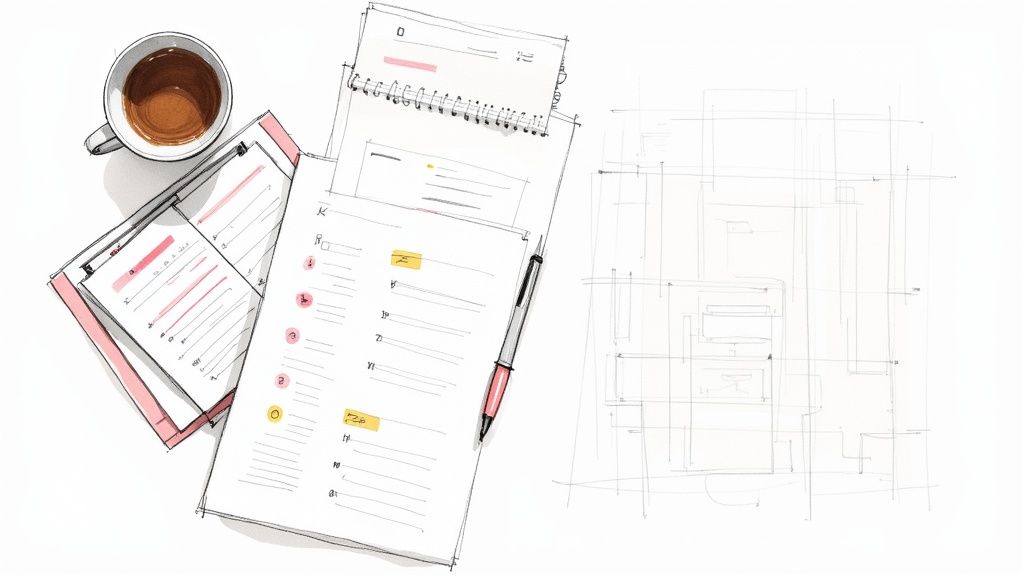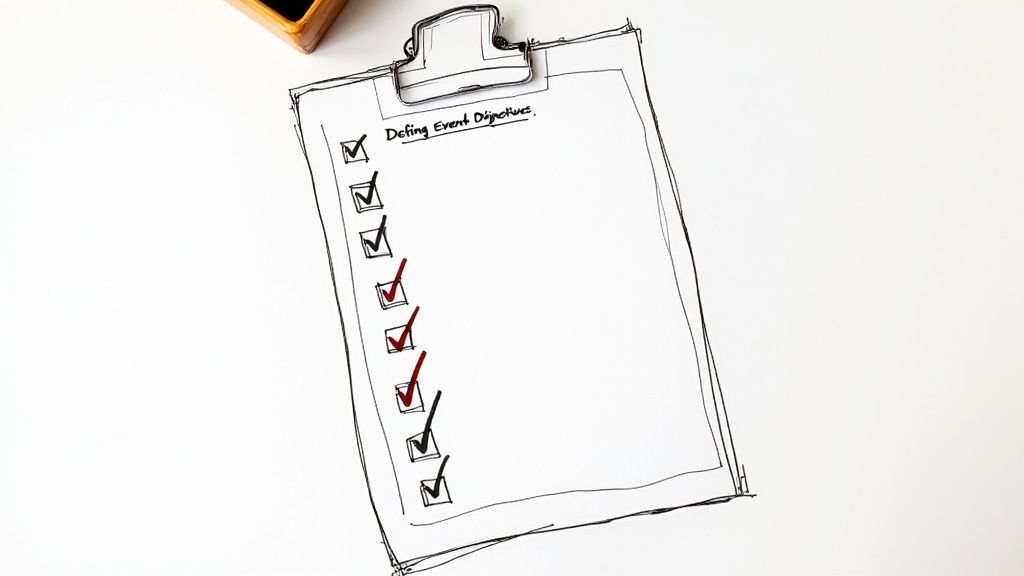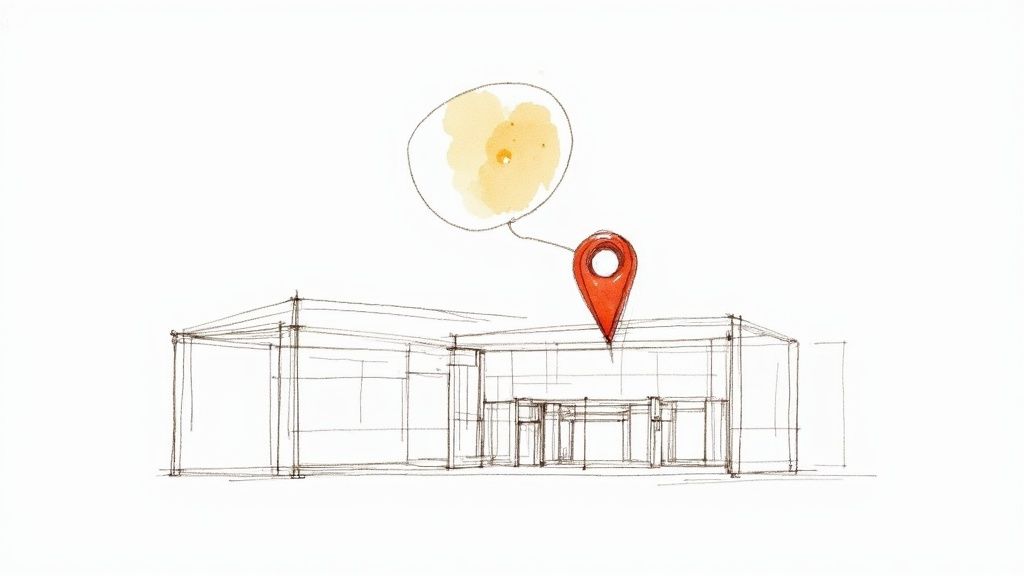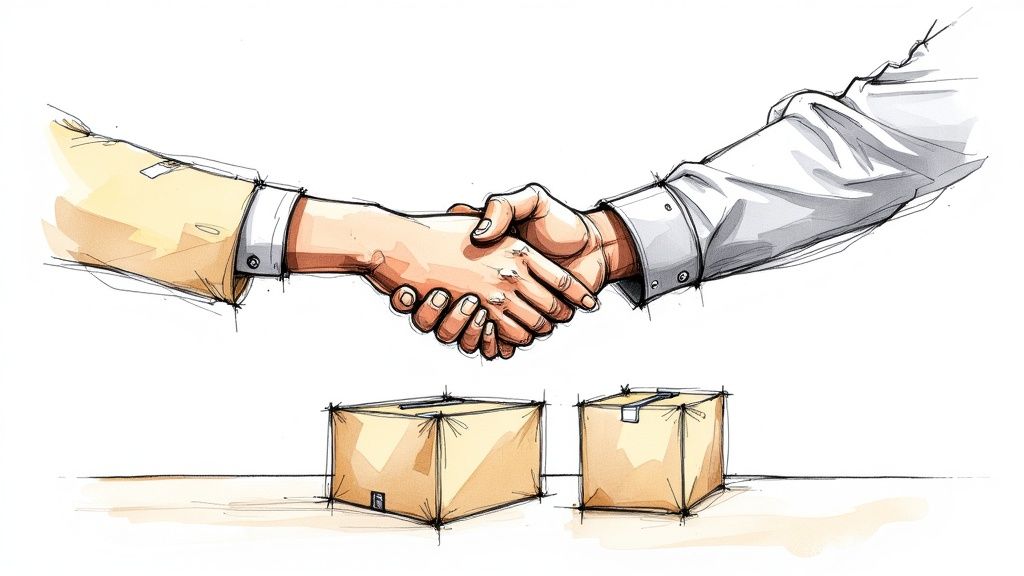October 1, 2025

Before you book a single venue or draft a guest list, the real work of event planning begins. It all starts with a rock-solid foundation. You have to nail down your 'why' before you can even think about the 'how.' This initial strategy phase is what separates a truly memorable event from one that just... happens.

Every great event I've ever been a part of started with a clear strategy, not a checklist of logistical tasks. It's easy to get caught up in the excitement of planning, but you have to anchor everything to a core purpose first. Why are you even hosting this event? That single question will guide every decision you make down the line.
This is where you turn a cool idea into a concrete, workable plan. It’s about so much more than just picking a date; it’s about defining who you want in the room and what you want them to walk away feeling, thinking, or doing.
The events industry is absolutely massive, and it's on track to hit $2.5 trillion by 2035. A big reason for that is that 59% of people crave in-person experiences. With 78% of organizers calling live conferences their most effective marketing tool, the pressure is on to get it right. You can find more of these insights in these event industry statistics from Eventgroove.
Your event goals are your compass. They dictate everything. Are you trying to generate a flood of new sales leads, raise money for a cause you care about, or simply build a stronger community? You have to be specific here. A vague goal like "build brand awareness" is a recipe for a muddled event.
Instead, think in terms of measurable results. For example:
A well-defined goal acts as a filter. When you're deciding between two keynote speakers or debating a menu choice, you can ask, "Which option gets us closer to our primary objective?" This simple question eliminates ambiguity and keeps your planning focused.
Once you know your 'why,' it’s time to figure out your 'who.' The experience you design for a C-suite corporate retreat is going to be worlds apart from a music festival for college students. I always recommend creating detailed attendee personas to get inside their heads and understand what they really want and expect.
Think about a software company launching a new product. Their audience isn't just "people in tech." It's much sharper: 'Project managers at mid-sized companies who are losing sleep over workflow inefficiencies.' See the difference? That level of detail sharpens everything from your marketing copy to the content you deliver on stage.
Before you dive into the nitty-gritty of planning, it's crucial to lay out these foundational pillars. This table summarizes the core components of your event's strategic blueprint.
Getting these elements down on paper ensures everyone involved—from your marketing team to your on-site volunteers—is working from the same playbook.
To keep all this organized, you need a central document that everyone can refer to. An event brief is perfect for this. To help you get started, we've put together a guide and a downloadable event brief template to make sure this crucial first step is a smooth one.
With a solid vision in place, it's time to get down to brass tacks. This is where your big idea meets the bottom line—a critical stage where you figure out the financial and logistical puzzle of your event. A well-built budget is your roadmap; it’s not just a spreadsheet, but a living document that guides every decision and helps you avoid nasty surprises down the road.
Start by brainstorming every possible expense. I mean everything. You've got the obvious big-ticket items like the venue and catering, but what about the little things? I'm talking about city permits, liability insurance, credit card processing fees, and even the post-event cleaning crew. These are the "hidden" costs that can absolutely wreck a budget if you haven't planned for them.
To make sense of it all, it helps to break the budgeting process into a few clear stages. This is a great visual for how to think about the flow of managing your event finances from start to finish.

As you can see, it’s a simple progression: estimate your total costs, allocate your funds, and then—this is the most important part—actively monitor your spending. It’s the only way to stay on track. If you want to really dig into the nitty-gritty, we've got a complete guide on https://groupos.com/blog/budgeting-an-event.
A smart financial plan is about more than just listing costs; it’s about actively looking for ways to be more efficient. And right now, that's more important than ever. Industry forecasts predict that while event budgets might rise by around 11% in 2025, the actual costs for services could jump by 12%.
So how do you close that gap? Planners are getting creative. We’re seeing a lot more events in second-tier cities to save on venue and travel costs, and more people are partnering with their local Convention and Visitor Bureaus (CVBs) for free resources and support.
Pro Tip: Always, always build a contingency fund of 10-15% into your total budget. This isn't being pessimistic; it’s being a professional. It's for the last-minute AV request, the surprise shipping fee, or the sudden jump in material costs. Trust me, you'll be glad you have it.
To keep everything organized, I highly recommend using a dedicated event budget planning template. It helps you track your spending against your projections in real-time, so you always know exactly where you stand.
Once your budget is set, you can start securing the partners who will help bring your vision to life. This isn't just about finding the lowest price. It's about building a team of reliable, talented people who get what you're trying to do and can deliver without a hitch.
When you're vetting potential vendors, here’s my non-negotiable checklist:
Think about a 300-person conference. Your vendor list will likely include a venue, a catering company, an AV provider, a registration platform like GroupOS, and maybe a transportation service. Each one requires careful vetting and negotiation to lock in a great experience for your attendees while staying firmly within your budget. This logistical backbone is what separates a good event from a truly seamless one.

Okay, you’ve locked in your budget and started wrangling the logistics. Now for the fun part—designing the actual experience for your attendees. This is where you get to move past the spreadsheets and get creative. A truly great event isn’t just a schedule of speakers and sessions; it's a journey that feels intentional and engaging from the moment someone registers to the moment they leave.
It all starts with a compelling theme. Think of your theme as the North Star for every decision you make. It guides your marketing copy, venue decor, session topics, and even the food you serve. It’s the narrative that ties everything together and makes the whole experience feel immersive.
The fastest way to lose an audience is with a flat, predictable agenda. We’ve all been to those events where you’re stuck in a chair for hours on end. To keep the energy high, you need to build a schedule with variety and plenty of breathing room for networking and processing what's been learned.
Let’s say you’re planning an annual industry awards night. The basic version is a cocktail hour, dinner, and a long list of awards. Yawn. But a thoughtfully designed journey could be so much more.
Suddenly, a standard ceremony becomes a multi-act story that keeps your guests hooked all night.
The most successful events make attendees feel like active participants, not just passive observers. Every element, from a live poll during a keynote to a themed networking break, should be a deliberate choice aimed at deepening their connection to the content and each other.
This is where modern event tech becomes your best friend. Simple tools can transform a one-way presentation into a two-way conversation. An event app with a live Q&A feature, for instance, lets attendees submit and upvote questions. This ensures the speaker addresses what the audience really wants to know, not just what they assume is important.
Live polling is another fantastic tool. You can kick off a workshop by gauging the room's expertise on a topic or spark a debate by asking for opinions on a controversial point. When you give attendees a chance to actively participate, they don't just absorb the content—they become part of it. This is a fundamental part of learning event planning how to design a modern, effective gathering.
You can have the most incredible event planned down to the last detail, but it won't matter if no one shows up. This next phase is all about getting the word out—building buzz, creating that "can't-miss" feeling, and making it dead simple for people to register. This is where you turn curiosity into actual attendees.
Your promotion strategy can't be an afterthought. It needs to be a multi-channel plan that kicks off weeks, or even months, before the event. Think of it like telling a great story that unfolds over time, building anticipation with every email, social post, or ad.
Before you even think about sending that first promotional email, take a hard look at your registration process. A clunky, confusing sign-up form is the fastest way to kill someone's excitement. I've seen it happen time and time again—every extra click or unnecessary question is another chance for them to give up.
Your registration page should be clean, work perfectly on a phone, and be focused on one goal: getting that sign-up.
This is where a dedicated platform like GroupOS really shines. You can spin up beautiful ticketing pages with custom forms, easily add VIP upgrades, and keep track of everything in one spot. It just makes life easier for you and your future guests.
Your registration page isn't just a form; it's the front door to your event. Make it welcoming. A difficult sign-up process sends a clear message: this event might be just as disorganized.
Putting all your eggs in one marketing basket is a recipe for a half-empty room. The best promotion plans meet people where they are, using a mix of channels to build momentum and make sure your message is heard loud and clear.
Imagine you're running a B2B tech conference. Instead of a generic social media blast, you could run a highly targeted ad campaign on a platform like LinkedIn, focusing on specific job titles and industries. That's how you make sure your budget is actually reaching the right professionals.
At the same time, email is still a beast for driving sign-ups. Don't just send one generic blast. Segment your list. For instance, why not offer a special "alumni" discount to people who came last year? It makes them feel valued and gives them a reason to sign up now. Combine this with a well-timed early-bird discount, and you’ll create a powerful sense of urgency that can lock in a solid base of attendees right from the start.
If you're looking for more ways to get the word out, we've put together a list of other effective event promotion ideas to help you fill your pipeline.

After all the emails, spreadsheets, and late nights, it’s finally here. Event day. This is where the magic happens, and all your hard work is put to the test. Success at this stage is all about real-time coordination, clear communication, and staying cool under pressure.
The real goal is to make the entire experience feel effortless for your guests. They should never see the frantic paddling happening beneath the surface. It all comes down to a proactive approach, managing every detail from the moment guests arrive to the final wave goodbye.
Those few hours before the doors swing open are absolutely crucial. This is your last chance for a final run-through of all your tech—from the presentation clickers and mics to the main stage lighting. Trust me, there’s no better feeling than seeing it all work perfectly right before go-time.
Your team briefing is just as critical. Don’t just hand out a schedule and hope for the best. Walk your staff and volunteers through the entire attendee journey. Make sure everyone has a clear, defined role. Who’s handling the speaker green room? Who’s the go-to person if the AV acts up? When people know what they own, you avoid chaos.
For bigger events, don't overlook security. Having professional protection in ensuring public safety at large events is about more than just crowd control; it’s about creating a safe, comfortable environment. Their presence lets your team focus on what you do best: creating an amazing guest experience.
A Proactive Mindset: The secret to a smooth event isn’t just hoping nothing goes wrong—it’s knowing something will and being ready for it. What’s your plan if the keynote speaker is stuck in traffic? What if there's a medical issue? Think through these scenarios and have a clear protocol in place.
Let’s be honest, the first impression happens at the check-in desk. Long, disorganized lines can kill the vibe before the event even starts. This is where having the right tools in your corner makes a world of difference.
Using a solid event check-in app is a total game-changer. Something like GroupOS that lets you scan QR codes for instant entry can eliminate those dreaded lines, freeing up your team to offer a warm, personal welcome instead. You can find more tips on picking the right one in our event check-in app guide.
And please, don't underestimate the power of good signage. It’s your silent helper, guiding people to sessions, restrooms, and coffee stations. Put yourself in the shoes of a first-time guest and place signs at every point where someone might hesitate or get confused.
No matter how well you plan, little things will pop up. The Wi-Fi will drop, a mic battery will die, a session will run late. It happens. What truly matters is how your team responds. Empower them to solve small problems on their own and keep everyone connected through a dedicated channel like a group chat. Real-time updates prevent small hiccups from turning into big problems.
Think the event's over when the last person heads for the door? Not even close. In fact, some of your most important work is just getting started. This is your chance to figure out what really hit the mark, get honest feedback, and start building momentum for whatever you do next.
Before you even think about spreadsheets and data, your first move is to say thank you. Get those personalized follow-up emails out to everyone—attendees, speakers, sponsors, the whole crew—within 24 hours. It’s a small touch, but it goes a long way in keeping the good vibes going and cementing those relationships for the future.
Once the thank-yous are out, it's time to get your hands dirty with the data. The big question is: did you achieve what you set out to do? If your goal was to generate 150 qualified leads, now's the time to open up your registration platform and see the final tally.
Start by digging into the metrics right inside your event management software, like GroupOS. I always look at a few key things first:
Numbers on a dashboard tell you the 'what,' but they don't always tell you the 'why.' For that, you absolutely have to talk to your attendees. If you’re serious about honing your event planning how to skills, post-event surveys are non-negotiable.
My advice? Keep it short and to the point. No one wants to fill out a 30-question monster. Ask about their overall satisfaction, what they thought of the venue, the content, and the networking. I always include a Net Promoter Score (NPS) question: "On a scale of 0-10, how likely are you to recommend this event to a colleague?"
Don't just focus on the attendees. Get your internal team and key volunteers in a room for a debrief while the event is still fresh in their minds. They saw everything from the ground level and can point out logistical wins or bottlenecks that you'd never find in a spreadsheet.
Lastly, it’s time to talk money. Gather up all your final numbers—ticket sales, sponsorship income, and every last expense—to calculate your return on investment (ROI). This is the number that demonstrates your event's value to leadership and helps you secure the budget for the next one. Trust me, these insights are everything.
Even the most seasoned planners hit a snag now and then. Let's tackle some of the most common questions that come up when you're in the thick of planning an event.
I've learned one thing over the years: something will always change at the last minute. It's just part of the job. The trick isn't to prevent change, but to plan for it.
For example, what happens if a speaker gets sick? I always have a backup plan, whether that's another speaker on a shortlist or even a pre-recorded session I can play in a pinch. You also need to keep your vendors in the loop constantly. Good, open communication means they'll be far more willing to help you out when you suddenly need to change the meal count or tweak the A/V setup.
My best advice for handling last-minute chaos? Build flexibility right into your event timeline from day one. I always add buffer time between sessions and during setup. That little bit of extra cushion is a lifesaver when you need to solve an unexpected problem without derailing the whole schedule.
Don't get distracted by shiny new tech; focus on tools that solve a real problem for you and your attendees. For a huge conference, a dedicated event app is a game-changer for keeping agendas, maps, and announcements all in one place. But for a smaller workshop? It’s probably an unnecessary expense.
One piece of tech that's almost always non-negotiable is a solid registration and ticketing system. Anything that speeds up the check-in process is a huge win. Tools like GroupOS that offer QR code check-ins can make that first impression at the door smooth and professional instead of slow and frustrating.
It all comes down to clear and consistent communication. From the moment someone lands on your event website or registration page, they should know exactly what to expect. Don't be vague. If you're hosting a casual networking mixer, say that. If it's a black-tie gala, make the dress code impossible to miss.
I always send a "Know Before You Go" email a few days out. This single email can prevent dozens of questions on event day. Make sure it includes the essentials:
This small step makes a huge difference. Guests arrive feeling prepared and excited, not confused and stressed.
Ready to manage every detail of your event with confidence? GroupOS provides an all-in-one platform to handle ticketing, attendee communication, and post-event analytics seamlessly. Start your journey with a free trial at https://groupos.com.


